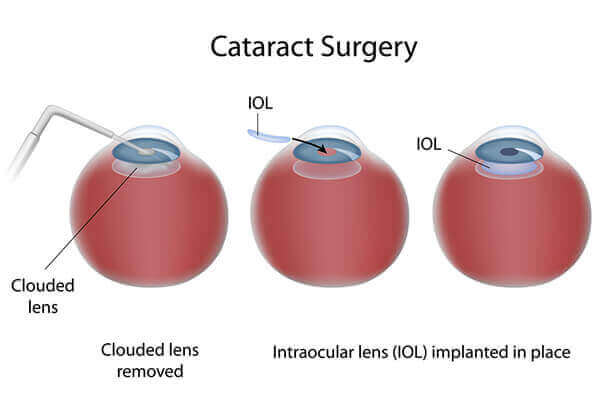About Cataract Surgery
How is a Cataract Treated?
The symptoms of early cataracts may be improved with new eyeglasses, brighter lighting, anti-glare sunglasses, or magnifying lenses. If these measures do not help, surgery is the only effective treatment. Surgery involves removing the cloudy lens and replacing it with an artificial lens.
A cataract needs to be removed only when vision loss interferes with your everyday activities, such as driving, reading, or watching TV. You and your eye care professional can make this decision together. Once you understand the benefits and risks of surgery, you can make an informed decision about whether cataract surgery is right for you. In most cases, delaying cataract surgery will not cause long-term damage to your eye or make the surgery more difficult. You do not have to rush into surgery.

Sometimes a cataract should be removed even if it does not cause problems with your vision. For example, a cataract should be removed if it prevents examination or treatment of another eye problem, such as age-related macular degeneration or diabetic retinopathy. If your eye care professional finds a cataract, you may not need cataract surgery for several years. In fact, you might never need cataract surgery. By having your vision tested regularly, you and your eye care professional can discuss if and when you might need treatment.
If you choose surgery, your eye care professional may refer you to a specialist to remove the cataract.
If you have cataracts in both eyes that require surgery, the surgery will be performed on each eye at separate times, usually four to eight weeks apart.
Cataract Surgery
Cataract surgery is an outpatient procedure that involves the removal of the natural lens and replacement with an artificial lens implant. The procedure typically takes 10-15 minutes to perform. Please note that you may be at the surgery center for 2-3 hours total. When you arrive, your eye will be dilated and an IV will be started. You will be given some mild sedation and your eye will be made numb for the procedure.
The cataract is removed using ultrasound and a new lens implant is placed. The surgery is performed through a very small incision and stitches are almost never used. The eye typically heals very quickly following surgery.
Immediately following the surgery, you will be taken to the recovery room for a short time before you are discharged home. You will be given instructions for caring for your eye that day. Because of the sedation, you will want to take it easy for the rest of the day.
Are You a Candidate for Cataract Surgery?
Take our self-test and find out!
What is “Laser Cataract Surgery”?
The femtosecond laser allows a cataract surgeon to perform a few steps of cataract surgery using a laser. Although the laser has been available for over twelve years, studies have shown that it does not offer better outcomes than traditional cataract surgery, and in some ways may not be as good. According to studies, the laser does not have fewer complications, nor does it provide better outcomes¹, ². The patient pays a significant amount of money out of pocket for this technology (it is not covered by insurance). We have evaluated femtosecond laser cataract surgery but have not adopted it at Eye Associates of New Mexico due to the high cost to the patient without actual clinical benefit. If this technology evolves to the point that it provides benefit to patients, then Eye Associates will further evaluate offering femtosecond laser cataract surgery.
https://www.aao.org/editors-choice/flacs-manual-cataract-surgery-yield-similar-refrac

